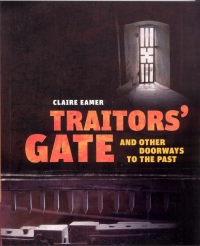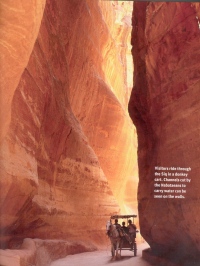| ________________
CM . . .
. Volume XV Number 5. . . .October 24, 2008
excerpt:
Eamer uses physical doorways or entrances found in eight UNESCO World Heritage Sites to introduce the reader to the history of the structures themselves and also to the people who lived and worked on both sides of the doorways through the ages. At times, the metaphor of doorway as entrance to history feels stretched, and the stories are not equally fascinating. Nevertheless, the high quality colour photographs, selected archival images and well-researched stories are informative and cover huge swaths of world history. Very recent archaeological work in Jordan has demonstrated that al-Khazneh, the two thousand year old stone doorway in the ancient city Petra, was part of a mausoleum created by the Nabataens, and it also served as a place of pilgrimage. Archaeologists used pottery shards to help date the ruins and evidence from tombs, burnt incense, animal bones and other signs of religious offerings to help establish the purpose of the structure. Similarly, archaeologists have used tools such as tree ring analysis (dendrochronology) of wooden beams to date the Spruce Tree House, an ancient cliff dwelling in Mesa Verde National Park, Colorado, that was occupied by Ancestral Puebloans in the twelfth and thirteenth centuries. Physical evidence, such as ancient garbage dumps and coprolites (ancient human poop), provides clues about diet in later years before the residents abandoned the settlement. Eamer also records the use of oral tradition from the descendants of the people to illuminate the stories of the ancestors. She makes note of the changing nature of archaeological work and the history of the creation of the National Park in order to preserve the site.
The Kremlin's Holy Antechamber in Moscow, The Meridian Gate, or Wu Men on the south side of the Forbidden City in Beijing, and the Cape Coast Castle, with its "door of no return," in Ghana are the remaining doorways featured in the book. The latter was a slave fort on the Gold Coast of Africa and served as the departure point for many African slaves sent across the Atlantic Ocean. Unobtrusive sidebars and photo captions are used to provide additional historical facts. Eamer also includes two bibliographies: "Further reading" includes printed works geared to juvenile or general adult readers, while a more scholarly "Selected bibliography" includes sources consulted that the targeted audience will likely not have access to. It is puzzling that Eamer did not include a citation to the official website for the UNESCO World Heritage Centre UNESCO. A detailed index helps to make this book useful for research projects. Recommended. Val Ken Lem is the Collection Evaluation Librarian at Ryerson University in Toronto, ON.
To comment
on this title or this review, send mail to cm@umanitoba.ca.
Copyright © the Manitoba Library Association. Reproduction for personal
use is permitted only if this copyright notice is maintained. Any
other reproduction is prohibited without permission.
NEXT REVIEW |
TABLE OF CONTENTS FOR THIS ISSUE
- October 24, 2008.
AUTHORS |
TITLES |
MEDIA REVIEWS |
PROFILES |
BACK ISSUES |
SEARCH |
CMARCHIVE |
HOME |

 Most of the doorways featured were built by literate societies where written records help to record the history of the structures and the lives of the people associated with the sites. The Sankoré Mosque in the northeast quarter of Timbuktu has served as a site of religious worship and scholarship for over 800 years. In London, the Traitors' Gate to the Tower of London is submerged under water during high tide. The complex of buildings at the site originated in Norman times and served many purposes over the centuries. The Castel Sant'Angelo (Castle
of the Holy Angel) in Rome began as a mausoleum or tomb for the Roman emperor Hadrian in the second century CE. It later served as a fortress and in the late sixth century became the site of a chapel built by order of Pope Gregory I in recognition of his vision of a warrior angel that he credited with curing a plague. Additions to the chapel provided living quarters for the popes, and later it served as a prison and military fortress until it was converted into a museum in 1901.
Most of the doorways featured were built by literate societies where written records help to record the history of the structures and the lives of the people associated with the sites. The Sankoré Mosque in the northeast quarter of Timbuktu has served as a site of religious worship and scholarship for over 800 years. In London, the Traitors' Gate to the Tower of London is submerged under water during high tide. The complex of buildings at the site originated in Norman times and served many purposes over the centuries. The Castel Sant'Angelo (Castle
of the Holy Angel) in Rome began as a mausoleum or tomb for the Roman emperor Hadrian in the second century CE. It later served as a fortress and in the late sixth century became the site of a chapel built by order of Pope Gregory I in recognition of his vision of a warrior angel that he credited with curing a plague. Additions to the chapel provided living quarters for the popes, and later it served as a prison and military fortress until it was converted into a museum in 1901.